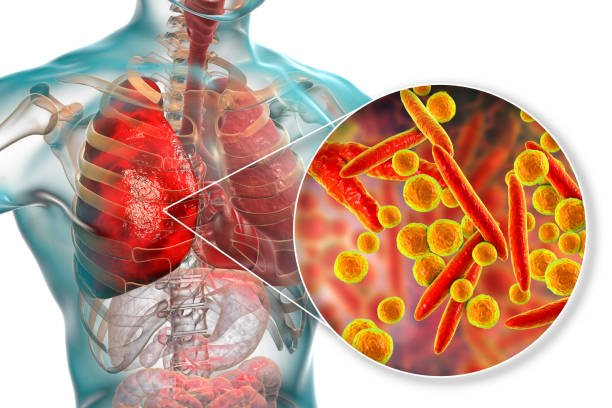Tuberculosis (TB) is a bacterial illness that impacts the lungs and various bodily regions. The germs that cause tuberculosis are bacteria(Mycobacterium tuberculosis). It most often affects the lungs
Organ escape from TB:(Due to high vascularity)
- Cardiac muscle
- Skeletal muscle
- Thyroid muscle

Common sites of active TB disease outside the lungs include:
- Kidneys.
- Liver.
- Heart muscles.
- Genitals.
- Lymph nodes.
- Bones and joints.
- Skin.
- Fluid surrounding the brain and spinal cord.
overview
Type
There are 2 types of TB:
- Latent TB infection: this is when someone is infected with TB but does not get sick, because their immune system can control the infection.
- Active TB disease: when the TB bacteria multiply and the immune system cannot control them. Active TB causes symptoms.
Spread
Tuberculosis (TB) is transmitted through the air, with tiny particles containing TB bacteria being expelled when an infected person coughs, speaks, sneezes, or sings. Contrary to common misconceptions, TB is not transmitted through activities like shaking hands, hugging, or sharing a bathroom. Upon inhalation, TB bacteria can settle in the lungs and potentially spread further within the body. The disease tends to propagate rapidly in environments characterised by close living quarters such as homes, hospitals, dormitories, or hostel
Your susceptibility to contracting TB increases if you:
- Have had close contact with someone with active TB, with the duration, frequency, and proximity of the contact influencing the risk level.
- Reside in a region where TB prevalence is high.
- Possess a compromised immune system.
Tuberculosis can’t spread by: kissing, sharing mouth devices, drinks and glasses, shaking hands
Symptoms
The signs of active tuberculosis (TB) disease in the lungs typically manifest gradually and deteriorate over several weeks. These symptoms may encompass:
- Chronic cough( often with blood)
- Low grade fever
- Evening rise of temperature
- Weight loss
- Patients may be cachectic.
- Night sweating
- Pain with breathing & coughing.
- Fever
- Chill
Diagnosis
The definite confirmation of pulmonary tuberculosis involves finding Mycobacterium tuberculosis in bodily fluids (such as sputum, bronchoalveolar lavage, or pleural fluid) or tissue samples (like pleural or lung biopsies) through laboratory tests like culture.Diagnosis of pulmonary tuberculosis is based on-
- Demonstration of the acid fast bacilli by Ziehl-neelsen stained smear and other stains.
- Detection of antibodies & antigens by immunological test.
- Detection of genes by NA based technique is used.
Treatment
Tuberculosis is treatable with a standard six-month regimen consisting of four antibiotics. Common medications include rifampicin and isoniazid. It’s crucial to adhere to the prescribed daily dosage for 4–6 months, and stopping the medication prematurely or without medical guidance can be hazardous. Doing so may lead to drug-resistant TB, where the remaining TB bacteria become impervious to the drugs. In cases where standard drugs are ineffective, a more aggressive treatment involving different medicines with higher toxicity is necessary. This condition is termed drug-resistant TB.
Prevention
Prevention is crucial in halting the transmission of tuberculosis (TB). This involves early detection and treatment of active TB to prevent its spread, as well as efforts to prevent the progression to active disease in individuals who have been exposed to TB or are known to be latently infected. Although vaccination with the Bacillus Calmette-Guerin (BCG) vaccine is largely ineffective in stopping transmission, the development of a more potent vaccine holds promise for significantly altering TB management strategies.
